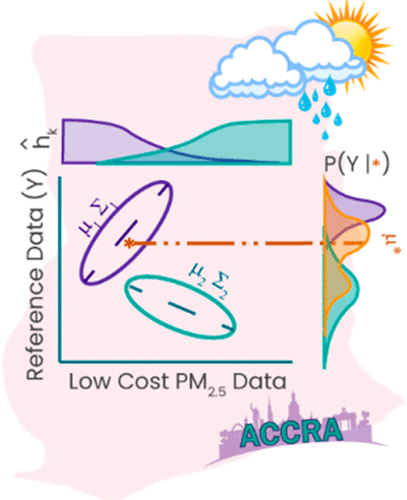当前位置:
X-MOL 学术
›
ACS Earth Space Chem.
›
论文详情
Our official English website, www.x-mol.net, welcomes your
feedback! (Note: you will need to create a separate account there.)
Application of Gaussian Mixture Regression for the Correction of Low Cost PM2.5 Monitoring Data in Accra, Ghana
ACS Earth and Space Chemistry ( IF 2.9 ) Pub Date : 2021-08-25 , DOI: 10.1021/acsearthspacechem.1c00217 Celeste McFarlane 1 , Garima Raheja 1 , Carl Malings 2 , Emmanuel K. E. Appoh 3 , Allison Felix Hughes 4 , Daniel M. Westervelt 1, 5
ACS Earth and Space Chemistry ( IF 2.9 ) Pub Date : 2021-08-25 , DOI: 10.1021/acsearthspacechem.1c00217 Celeste McFarlane 1 , Garima Raheja 1 , Carl Malings 2 , Emmanuel K. E. Appoh 3 , Allison Felix Hughes 4 , Daniel M. Westervelt 1, 5
Affiliation

|
Low-cost sensors (LCSs) for air quality monitoring have enormous potential to improve air quality data coverage in resource-limited parts of the world such as sub-Saharan Africa. LCSs, however, are affected by environment and source conditions. To establish high-quality data, LCSs must be collocated and calibrated with reference grade PM2.5 monitors. From March 2020, a low-cost PurpleAir PM2.5 monitor was collocated with a Met One Beta Attenuation Monitor 1020 in Accra, Ghana. While previous studies have shown that multiple linear regression (MLR) and random forest regression (RF) can improve accuracy and correlation between PurpleAir and reference data, MLR and RF yielded suboptimal improvement in the Accra collocation (R2 = 0.81 and R2 = 0.81, respectively). We present the first application of Gaussian mixture regression (GMR) to air quality data calibration and demonstrate improvement over traditional methods by increasing the collocated PM2.5 correlation and accuracy to R2 = 0.88 and MAE = 2.2 μg m–3. Gaussian mixture models (GMMs) are a probability density estimator and clustering method from which nonlinear regressions that tolerate missing inputs can be derived. We find that even when given missing inputs, GMR provides better correlation than MLR and RF performed with complete data. GMR also allows us to estimate calibration certainty. When evaluated, 95% confidence intervals agreed with reference PM2.5 data 96% of the time, suggesting that the model accurately assesses its own confidence. Additionally, clustering within the GMM is consistent with climate characteristics, providing confidence that the calibration approach can learn underlying relationships in data.
中文翻译:

高斯混合回归在加纳阿克拉低成本 PM2.5 监测数据校正中的应用
用于空气质量监测的低成本传感器 (LCS) 在改善世界资源有限地区(如撒哈拉以南非洲)的空气质量数据覆盖方面具有巨大潜力。然而,濒海战斗舰受环境和源条件的影响。为了建立高质量的数据,LCS 必须与参考级 PM 2.5监测器搭配使用和校准。从 2020 年 3 月起,在加纳阿克拉,一台低成本的 PurpleAir PM 2.5监测器与 Met One Beta Attenuation Monitor 1020 搭配使用。虽然之前的研究表明多元线性回归 (MLR) 和随机森林回归 (RF) 可以提高 PurpleAir 与参考数据之间的准确性和相关性,但 MLR 和 RF 在阿克拉搭配方面产生了次优的改进(R 2 = 0.81 和R 2 = 0.81,分别)。我们首次将高斯混合回归 (GMR) 应用于空气质量数据校准,并通过将配置的 PM 2.5相关性和精度提高到R 2 = 0.88 和 MAE = 2.2 μg m –3来证明对传统方法的改进。高斯混合模型 (GMM) 是一种概率密度估计器和聚类方法,可以从中导出容忍缺失输入的非线性回归。我们发现,即使在给定缺失输入的情况下,GMR 也提供比使用完整数据执行的 MLR 和 RF 更好的相关性。GMR 还允许我们估计校准确定性。评估时,95% 的置信区间与参考 PM 2.5 一致数据 96% 的时间,表明该模型准确地评估了自己的置信度。此外,GMM 内的聚类与气候特征一致,为校准方法可以学习数据中的潜在关系提供了信心。
更新日期:2021-09-16
中文翻译:

高斯混合回归在加纳阿克拉低成本 PM2.5 监测数据校正中的应用
用于空气质量监测的低成本传感器 (LCS) 在改善世界资源有限地区(如撒哈拉以南非洲)的空气质量数据覆盖方面具有巨大潜力。然而,濒海战斗舰受环境和源条件的影响。为了建立高质量的数据,LCS 必须与参考级 PM 2.5监测器搭配使用和校准。从 2020 年 3 月起,在加纳阿克拉,一台低成本的 PurpleAir PM 2.5监测器与 Met One Beta Attenuation Monitor 1020 搭配使用。虽然之前的研究表明多元线性回归 (MLR) 和随机森林回归 (RF) 可以提高 PurpleAir 与参考数据之间的准确性和相关性,但 MLR 和 RF 在阿克拉搭配方面产生了次优的改进(R 2 = 0.81 和R 2 = 0.81,分别)。我们首次将高斯混合回归 (GMR) 应用于空气质量数据校准,并通过将配置的 PM 2.5相关性和精度提高到R 2 = 0.88 和 MAE = 2.2 μg m –3来证明对传统方法的改进。高斯混合模型 (GMM) 是一种概率密度估计器和聚类方法,可以从中导出容忍缺失输入的非线性回归。我们发现,即使在给定缺失输入的情况下,GMR 也提供比使用完整数据执行的 MLR 和 RF 更好的相关性。GMR 还允许我们估计校准确定性。评估时,95% 的置信区间与参考 PM 2.5 一致数据 96% 的时间,表明该模型准确地评估了自己的置信度。此外,GMM 内的聚类与气候特征一致,为校准方法可以学习数据中的潜在关系提供了信心。











































 京公网安备 11010802027423号
京公网安备 11010802027423号